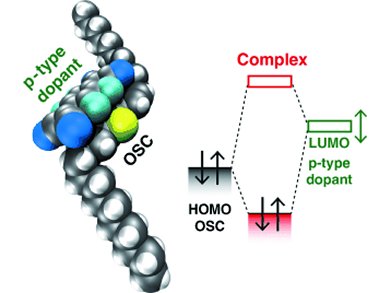Doping semiconductors allows precise control over the energy levels and, therefore, the properties and performance of a material.
Georg Heimel, Ingo Salzmann and a team of international researchers have studied two models of molecular doping of organic semiconductors (OSCs): the first is a more standard mechanism that involves charge transfer from the highest occupied molecular orbital (HOMO) of the OSC to the lowest unoccupied molecular orbital (LUMO) of the dopant for p-type doping, and in the other direction for n-type doping. A more recent alternative model is the frontier molecular orbital hybridization between the HOMO of the OSC and the LUMO of the dopant. This mechanism leads to the formation of a ground-state charge-transfer complex, in which occupation of the available states results in low doping efficiency.
The researchers, who are based in Germany, Japan, Belgium, and Columbia, experimented with varying the electron affinity of the dopant (to study the first mechanism) and the resonance integral (to investigate the second mechanism) with a view to optimizing the design of dopants. They found that the first mechanism is predominant, and thus the ionization energy of the OSC should match the electron affinity of the dopant, but also that the alternative mechanism plays also a role and the resonance integral should be minimized.
The authors emphasize that design strategies for new dopants should use steric shielding to prevent the frontier molecular orbitals of the dopant and the OSC from overlapping.
- Doping of Organic Semiconductors: Impact of Dopant Strength and Electronic Coupling,
Henry Méndez, Georg Heimel, Andreas Opitz, Katrein Sauer, Patrick Barkowski, Martin Oehzelt, Junshi Soeda, Toshihiro Okamoto, Jun Takeya, Jean-Baptiste Arlin, Jean-Yves Balandier, Yves Geerts, Norbert Koch, Ingo Salzmann,
Angew. Chem. Int. Ed. 2013.
DOI: 10.1002/anie.201302396




